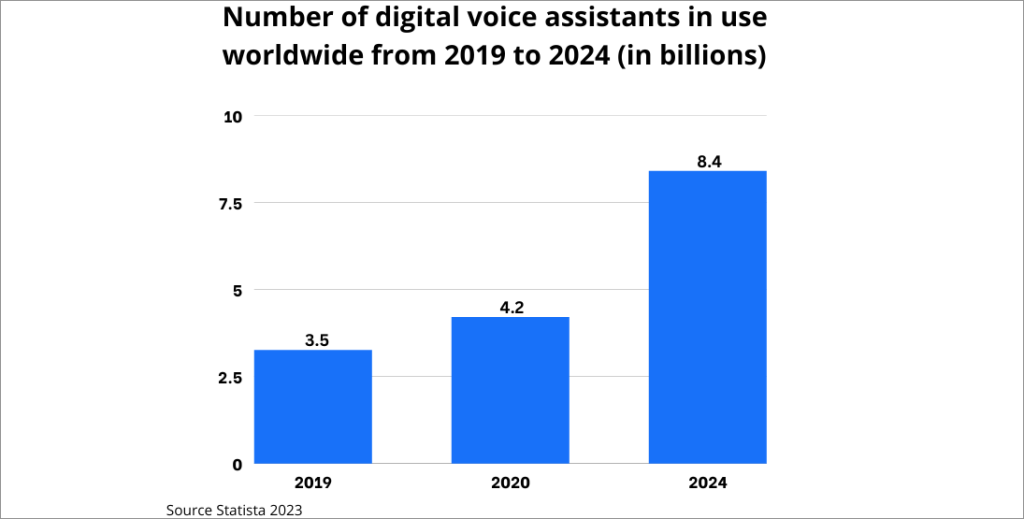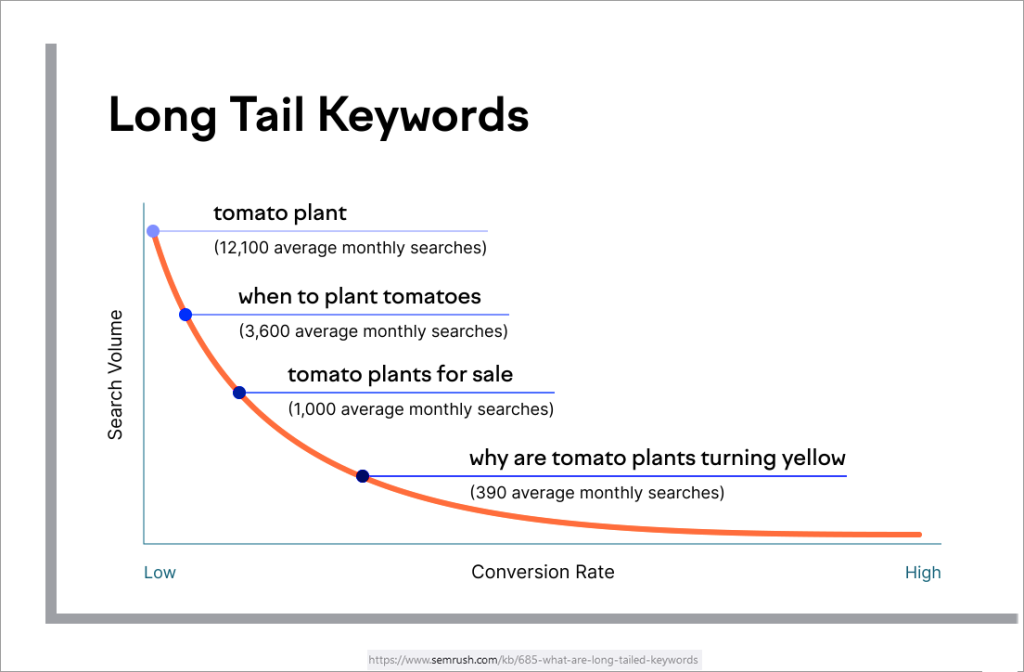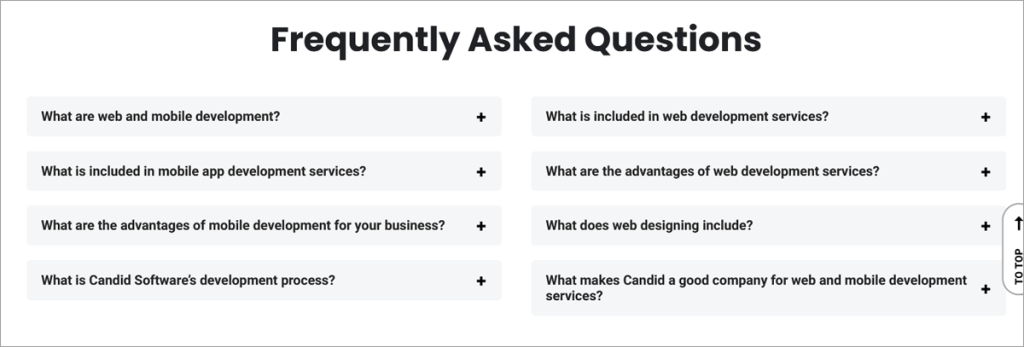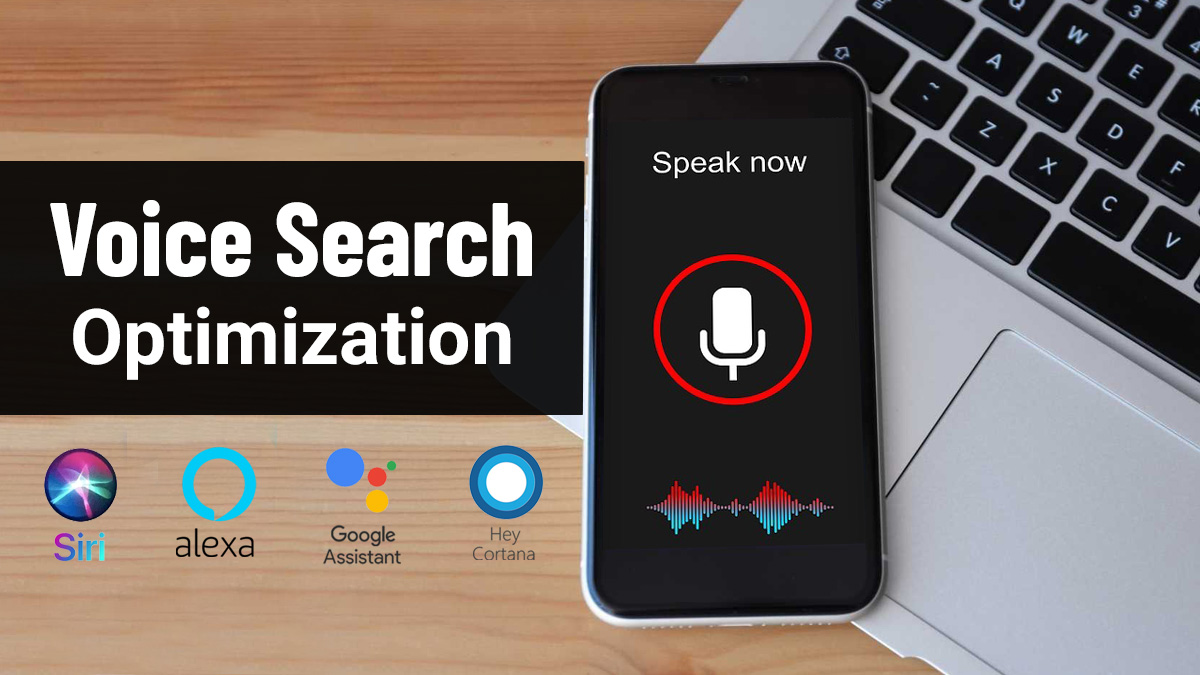Voice search optimization – it’s not just a buzzword; it’s a seismic shift in the digital landscape. As the digital realm continues to evolve, so do the ways we interact with it. The rise of voice-activated assistants like Siri, Alexa, and Google Assistant has fundamentally altered the way users seek information. Now, it’s not just about typing in a query; it’s about speaking it aloud.
But what does this mean for businesses and website owners? The answer lies in voice search optimization, a strategy that’s quickly becoming indispensable. If you’re not yet well-versed in this field, fear not – this blog post will unlock the power of voice search optimization, explaining why it matters and providing you with the essential knowledge to harness its potential.
The implications of voice search optimization are profound. It’s not just about keeping up with the latest trends; it’s about staying relevant in a world where voice-activated devices are ubiquitous. So, if you’re ready to dive into the intricacies of this game-changing strategy, let’s explore why it matters and how to do it effectively. Your digital journey is about to take an exciting turn – one that’s powered by the spoken word.
What Is Voice Search?

Voice search simplifies internet searches by enabling users to voice their queries rather than typing them. This technology is powered by artificial intelligence, which can identify and understand spoken requests before transmitting them to search engines for results.
While voice recognition technology has a history dating back to the early 1950s, it didn’t become practical until 2011 when IBM’s Watson made a significant breakthrough, famously winning on Jeopardy!
Today, voice search has become a commonplace feature. According to a survey by eMarketer, approximately 40% of internet users in the United States employ voice search, highlighting its widespread integration into various devices.
SEO service providers are instrumental in crafting conversational and technically optimized content for voice search, ensuring businesses stay competitive in the voice-activated era. They bring expertise in understanding user intent and implementing strategies crucial for success in voice search.
The Rising Trend of Voice Search and Its Impact on SEO

Voice search is fundamentally altering the digital environment, with significant repercussions for the field of SEO. Virtual assistants such as Alexa, Siri, and Google Assistant are increasingly becoming integrated into our daily routines and their market size is expected to be $50 billion in 2029. Consequently, people are more inclined to voice their queries rather than type them. This shift in user behavior necessitates a reevaluation of traditional search engine optimization practices.
Voice search queries often resemble natural conversation and are typically longer than text-based searches. This has implications for keyword strategy and content optimization, with an increasing focus on natural language processing, semantic search, and long-tail keywords.
Small businesses, in particular, stand to be heavily impacted. Voice searches often seek local services and information, making it crucial for your website to be easily discoverable by people in your local area through voice commands. Providing concise and accurate answers to frequently asked questions can boost your chances of appearing in voice search results. Adapting your SEO approach to cater to voice search is essential for businesses and website owners striving to stay ahead in a rapidly evolving digital world.
Also Read: Top SEO Trends of 2025 to Follow for Higher Rankings
Importance of Optimizing Website Content for Voice Search

Optimizing your website content for voice search is no longer optional; it’s essential in today’s rapidly evolving digital landscape. With the rise of voice-activated virtual assistants like Siri, Alexa, and Google Assistant, the way people search for information online has fundamentally changed. Here’s why optimizing for voice search is critical:
- Changing User Behavior: Voice search mimics natural conversation, featuring longer and more specific phrases. To stay relevant, websites must adapt their content to align with these evolving search patterns.
- Improved User Experience: Voice search simplifies the process of finding information, especially on mobile devices and smart speakers. Websites optimized for voice queries offer a more user-friendly experience, leading to greater customer satisfaction.
- Competitive Edge: As more businesses recognize the importance of voice search, optimizing your site for voice queries can help you stand out from the competition. Appearing as the top result in a voice search can elevate brand recognition and credibility.
- Emphasis on Local SEO: Voice searches often include local queries or “near me” searches. Optimizing your website for voice search can significantly benefit local businesses by driving both online engagement and in-store visits.
- Future-Proofing: The prevalence of voice search is only expected to increase. By optimizing your website now, you ensure it remains relevant and up-to-date in the years to come.
Understanding Voice Search
What Is Voice Search and How Does It Work?
Voice search is a technology that allows users to search the internet, retrieve information, or execute tasks by speaking rather than typing, and it is expected that the total number of voice assistants will be 8.4 billion in 2025. This process involves two key components: speech recognition and natural language processing. When a user poses a question, the voice assistant converts their spoken words into text using advanced speech recognition technology.
Next, natural language algorithms analyze this text to discern the user’s intent. The assistant then retrieves relevant information or performs actions based on its understanding, utilizing extensive online databases and machine learning algorithms to provide accurate and useful responses.
Also Read: How to Run a Successful SEO Campaign in 2025?
Differences Between Voice Search Queries and Typed Queries
Voice search and typed search differ in several significant ways. Voice queries are generally longer and more conversational, mirroring natural speech patterns. In contrast, typed queries are often shorter and more direct.
Voice searches tend to use conversational language and may include additional context or qualifiers. They are usually more specific and nuanced, often taking into account the situation’s context.
Furthermore, voice searches commonly focus on local queries, such as directions or finding nearby stores. These searches may yield direct answers, unlike typed queries that typically return a list of search results. This underscores the importance of optimizing content for voice search as the technology continues to evolve.
The Impact of Mobile on Voice Search
Correlation Between the Increase in Mobile Use and Voice Search
The unmistakable link between the rise of mobile device usage and the growing popularity of voice search is hard to ignore. With smartphones now ubiquitous, voice search has become an increasingly popular option for people, with 27% of the world population using mobile for voice search. This correlation is facilitated by the portability of smartphones, making voice commands a practical choice for those who are mobile.
The growing reliance on mobile devices for quick information retrieval has amplified the role of voice search. This trend highlights the intertwined relationship between mobile use and the rise of voice-activated queries.
Importance of Mobile Optimization for Voice Search
Optimizing your website for mobile devices is crucial when it comes to voice search. This is especially relevant in a society that is becoming increasingly dependent on mobile technology. People frequently use their smartphones to conduct quick searches, and voice commands make this even more convenient by allowing hands-free operation.
Websites that are both mobile-friendly and optimized for voice search ensure their content is accessible on devices where voice search is most commonly used. In essence, making a website compatible with mobile devices is not just an option; it’s a necessity for staying competitive in the digital age. By doing so, you help users easily find the information they need and ensure your website remains relevant in a mobile-centric world.
Also Read: Unlocking Profits with Long Tail Keyword Optimization: Your Essential Guide for 2025
Importance of Long-Tail Keywords in Voice Search
The Role of Long-Tail Keywords in Voice Search
Long-tail keywords play a critical role in optimizing for voice search. When people use voice search, they generally speak to their devices in a more conversational manner, using longer and more specific phrases. These long-tail keywords closely align with the natural language patterns people use in voice queries.
Incorporating these targeted keywords into your content enhances your likelihood of ranking higher in voice search results. Utilizing long-tail keywords not only improves your site’s visibility but also enables you to understand user intent better, making your content more relevant and valuable.
Strategies to Identify and Incorporate Long-Tail Keywords
Implementing long-tail keywords that are less commonly searched but highly targeted is an essential component of a modern SEO strategy. These focused keywords enable you to reach a niche audience more likely to engage with your content. Below are five practical tips to identify and implement long-tail keywords effectively.
- Tools for Finding Keywords: Leverage tools like Google Keyword Planner, Ubersuggest, and SEMrush to identify potential long-tail keywords. Look for phrases that are both relevant to your subject matter and specific to your niche.
- Study User Intent: Grasping why users are conducting specific searches is crucial for identifying relevant long-tail keywords. Reflect on the problems or questions your content aims to solve and formulate phrases that align with those specific needs. This approach ensures your content directly addresses what users are seeking.
- Use Voice Search Trends: As voice search gains popularity, it’s crucial to keep tabs on the natural language queries people are using. Such phrases often make excellent long-tail keywords. Incorporating these into your content allows you to align with emerging voice search trends.
- Analyze Your Competitors: Examine the keywords your successful competitors are focusing on, especially those who rank highly in search results. While you shouldn’t copy them verbatim, this research can inspire your own long-tail keyword strategy.
- Use Long-Tail Keywords: Once you’ve identified a list of relevant, specific keywords, integrate them seamlessly into your content. Create high-quality material that naturally incorporates these phrases. Avoid keyword stuffing and prioritize readability and value for the user.
By adopting these strategies for identifying and incorporating long-tail keywords, you can create content that resonates with your audience and improves your website’s ranking for specific voice search queries.
Structuring Your Content for Voice Search
Importance of Using a Conversational Tone

Adopting a conversational tone in your content is crucial for engaging your audience and fostering a connection with them. This relaxed style mirrors natural speech patterns, making it particularly relevant for voice search optimization. Content written in a conversational manner is easier for users to understand and relate to, which enhances user engagement.
Utilizing a conversational tone not only builds rapport with your readers but also aligns with voice-activated search queries. This can improve your brand image, boosting users’ trust and satisfaction. Moreover, a conversational style increases the chances of your content appearing in voice search results due to its similarity to natural speech.
The Role of Q&A Formats and How to Utilize Them

Question and Answer (Q&A) formats are an excellent way to provide concise and clear information to your audience. To utilize this format effectively, compile a list of frequently asked questions related to your topic and offer straightforward, succinct answers. This approach not only enhances readability but also increases the likelihood of your content being featured as a top answer in voice search results.
Incorporating organized Q&A sections into your content can significantly enhance its performance in voice search rankings while also establishing you as an authority in your field.

Local SEO and Voice Search
Significance of “near me” Queries and Local SEO in Voice Search
For many businesses, local SEO plays a crucial role in digital marketing. Local searches account for approximately 46 percent of all online queries, and these searches often represent highly engaged potential customers. These are the individuals most likely to visit your physical store and make an immediate purchase. Therefore, ranking high in local search results is vital, particularly if you own a brick-and-mortar shop.
As voice-activated virtual assistants become more prevalent, people increasingly turn to local businesses like restaurants or gas stations to meet their immediate needs while on the go. Employing local SEO strategies, such as optimizing your Google My Business listings, ensures that your business receives prominent visibility in voice search results for these local inquiries. This not only boosts foot traffic to your physical location but also enhances your online engagement with potential customers.
Local SEO serves as the foundation that enables companies to appear in search results when individuals use their mobile devices to search for nearby products or services. It significantly enhances your company’s visibility and accessibility to customers seeking local solutions, which, as mentioned earlier, often translates into instant sales from highly interested buyers.
Tips on Optimizing for Local Voice Searches
Optimizing for local voice searches is crucial for businesses wanting to reach nearby customers who use voice search on their mobile devices. Here are five actionable tips to improve your local voice search presence:
- Optimize Google My Business: Ensure your business is easily discoverable on Google by claiming and optimizing your Google My Business (GMB) listing. Ensure that all your business details are accurate, including your name, address, phone number, operating hours, and the categories you operate in. GMB is a critical source for voice search, particularly for local queries.
- Use Local and Long-Tail Keywords: Populate your website’s content with specific keywords and phrases that resonate with your local community. Also, make use of long-tail keywords that people might use during voice searches. For example, phrases like “best coffee in [your city]” or “nearest doctor to me” can be very effective.
- Implement Structured Data Markup: Implementing structured data markup helps organize the information on your website in a way that’s easier for search engines to interpret. This is essential for providing key details about your business, such as your location, contact information, and hours, making it more likely to appear in relevant search results.
- Create Local Content: Create content that is tailored to events, news, or trends in your local area. This not only establishes your business as a local authority but also aligns with the types of queries that people often make through voice searches within your locality.
- Encourage Reviews and Ratings: Positive online reviews can significantly enhance your visibility in local searches. Prompt satisfied customers to share their experiences on review platforms like Google and Yelp. Proactively responding to reviews, both positive and negative, demonstrates your commitment to customer satisfaction.
Optimize Website Speed for Voice Search
Why Voice Search Requires Fast-Loading Websites?
Voice search involves asking a digital assistant, like Siri or Google Assistant, to find information for you. A rapid response is crucial for a smooth user experience. Slow-loading websites not only frustrate users but also impede seamless interactions with voice search features. Ensuring quick website load times is vital for providing accurate and prompt answers, thus making voice search more efficient and user-friendly
Steps to Improve Website Speed
Improving website speed is crucial for user satisfaction, higher search engine rankings, and overall site performance. Here are five key strategies to speed up your website:
- Optimize Multimedia: Compress the sizes of images and videos without compromising quality. Utilize responsive image formats and implement lazy loading, which defers the loading of media files until they’re visible on the user’s viewport.
- Leverage Browser Caching: Enable browser caching to store static files on the user’s device temporarily. This eliminates the need for the browser to re-download these files during subsequent visits, resulting in faster page load times.
- Reduce HTTP Requests: Speed up your site by reducing the number of HTTP requests. This can be achieved by consolidating CSS and JavaScript files and using CSS sprites for smaller images. Fewer requests lead to quicker loading times.
- Use a Content Delivery Network (CDN): A CDN distributes your website’s content across multiple servers located in various geographical areas. This brings the content closer to the end-users, speeding up access and loading times.
- Optimize Scripts: Simplify your HTML, CSS, and JavaScript code by removing unnecessary elements. Efficient coding results in faster loading times. Consider loading scripts asynchronously to prevent any delays in page rendering.
Utilizing Schema Markup for Voice Search

What Is Schema Markup and Why is it Important for Voice Search?
Schema markup, also known as structured data, involves the process of adding code to a website’s HTML. It provides search engines with additional information about the content of the site, enabling them to better understand the context and making it more accessible to visitors.
Schema markup holds particular significance in the realm of voice search. According to one study, nearly 40% of voice search results are generated from a highlighted snippet, underscoring the pivotal role played by structured data. This markup increases the chances of your content being selected for a highlighted snippet, which often provides direct answers to voice search queries. Effective implementation of schema markup assists search engines in retrieving concise and relevant responses for voice queries, consequently boosting your site’s visibility.
How to Implement Schema Markup on Your Website?
Adding schema markup to your website is a strong way to improve how search engines find your site and help people navigate your content. Here are five things you can do to begin:
- Find Suitable Markup: Determine the type of schema markup that aligns best with your content. The common categories include articles, events, local businesses, products, and reviews. Your choice should reflect the nature of your content and the information you wish to highlight.
- Create Schema Markup Code: To create the schema markup, you can either consult the schema.org website or use online tools that automatically generate the code. These tools provide snippets of code that can be integrated into your website’s HTML.
- Add Markup to Web Pages: Add the generated schema markup code to the appropriate sections of your web pages, typically within the script or meta tags. Ensure that the tags accurately represent the content displayed on the page.
- Test the Markup: Use Google’s Structured Data Testing Tool or other schema validation services to verify that your code is error-free and properly structured. This is a crucial step to prevent any issues that might confuse search engines.
- Monitor the Markup: Once your markup is live, monitor its performance and keep it updated to reflect any changes to your content. Schema markup is an ongoing task that requires regular attention to maintain its effectiveness in boosting your website’s visibility.
By following these steps, you can successfully implement schema markup on your website. This will not only help search engines better understand your content but also enhance the likelihood of your content being featured in both voice and traditional search results.
Creating a Google My Business Listing
The Role of Google My Business in Voice Search Results
Google My Business (GMB) plays a crucial role in voice search results by providing detailed, specific information about local businesses. When people use voice-activated services like Google Assistant to find nearby restaurants or plumbers, GMB listings serve as the source for the most relevant results. These listings feature key information such as the business name, location, contact number, hours of operation, customer reviews, and photographs.
Creating an optimized GMB profile significantly enhances a local business’s likelihood of appearing in voice search results. Given the rapidly evolving landscape of voice search, this is essential for businesses aiming to stay visible and attract more customers.
Steps to Create and Optimize a Google My Business Listing
Creating and improving a Google My Business (GMB) listing is really important for local SEO and being seen online. Here are five important steps to help you make and improve your GMB listing effectively:
- Create Your Listing: Visit the Google My Business website and log in using your Google account. Search for your business; if it’s already listed, claim ownership. If not, create a new listing by providing your business name, address, and other pertinent details.
- Provide Complete Information: Ensure the information you input is correct and consistent with your business’s Name, Address, and Phone Number (NAP). Also, include your website’s URL and select the business category that most accurately describes your services.
- Include Engaging Content: Enhance your profile by uploading high-quality images that represent your business well. Include exterior and interior shots, products, services, and even your team. Utilizing multimedia like photos and videos can add authenticity and engage potential customers more effectively.
- Update Your Listing Regularly: Regularly update your GMB listing with current operating hours, any special hours, and new services you offer. Utilize features like posts, updates, events, and special promotions to engage your audience and demonstrate that your business is active and responsive.
- Promote Customer Engagement: Be sure to respond to both positive and negative reviews to show your commitment to excellent customer service. Enable the messaging feature to make it easy for prospective customers to reach out with queries or feedback.
By following these guidelines, you can create an effective Google My Business listing that not only bolsters your online presence but also draws attention from potential customers in your local area. Make it a habit to review your listing regularly to ensure all information remains current and accurate.
Importance of Secure Websites for Voice Search
The Correlation Between Website Security (HTTPS) and Voice Search Ranking
HTTPS (Hypertext Transfer Protocol Secure) has become increasingly crucial for both SEO and achieving a high ranking in voice search results. Search engines like Google prioritize website security when determining how to rank websites.
Websites using HTTPS ensure that the data transmitted between your browser and the web server is encrypted and confidential. This level of security is essential for safeguarding user information and also contributes to better search rankings. In the realm of voice search, heightened security is particularly vital, as it helps search engines present trustworthy results to users.
Trust and credibility serve as key determining factors for search engines when selecting results for voice searches. Accordingly, HTTPS-enabled websites are more likely to rank higher and be featured in voice search results due to their enhanced security and reliability.
How to Secure Your Website?
In today’s digital landscape, securing your website is paramount. To start, obtain an SSL certificate to encrypt data exchanged between your website and its users, ensuring a safe and secure communication channel. Regularly updating your website software—including content management systems and plugins—is also crucial.
Such updates often include security patches that enhance your website’s protection. Additionally, consistently back up your website data and employ specialized security tools to shield it from prevalent risks. Utilize scanning and monitoring tools to identify any potential vulnerabilities or issues.
By taking these measures, you not only bolster your website’s security but also protect user information. Moreover, a secure website is likely to perform better in search engine rankings, including in voice search results.
Optimizing Content for Featured Snippets
The Connection Between Voice Search and Featured Snippets
The correlation between voice search and featured snippets is notable. Voice assistants like Alexa, Siri, and Google Assistant often rely on concise, informative answers known as featured snippets to respond to voice queries quickly.
Such short and precise answers are ideal for voice search, as they offer clear, direct responses. Websites that optimize their content for voice search stand a better chance of being sourced for these featured snippets.
This underscores the importance of structuring your website content in a straightforward and easily digestible manner. Doing so enhances your site’s visibility in voice search results.
Tips for Optimizing Content to Rank in Featured Snippets
To elevate your content’s chances of appearing prominently in search engine results—specifically as featured snippets—consider the following tips:
- Find High-Potential Queries: Research keywords to discover what questions people are asking within your industry. Focus on question-based searches, as these queries are more likely to produce featured snippets.
- Organize Your Content: Arrange your content to deliver concise and relevant answers to the identified questions. Utilize bullet points, numbered lists, and tables for clarity and easy navigation.
- Have Clear Headers: Compose succinct, descriptive headers that directly address the questions. Search engines often pull from header text to create featured snippets, so ensure that your headers are informative.
- Use Schema Markup: Employing schema markup assists search engines in better comprehending your content by supplying extra contextual information. This enhanced understanding can boost the chances of your content being featured.
- Create Quality and Trustworthy Content: Ensure your content is well-researched, accurate, and sourced from trustworthy references. Search engines like Google favor content that demonstrates expertise and reliability.
By adhering to these guidelines, you improve the likelihood of your content appearing in featured snippets. This not only serves users with valuable answers but also drives more traffic to your website. Keep track of your performance and continually update your approach to stay competitive in the evolving landscape of featured snippets.
Using Voice Search Analytics
Importance of Tracking the Performance of Voice Search Optimization
Understanding the efficacy of your voice search optimization is essential in the fast-evolving digital landscape. Voice search technology is rapidly changing, and businesses stand to gain by closely monitoring its effectiveness. Tracking performance not only informs you about popular keywords and content but also provides insights into user behavior and emerging search trends. This information allows businesses to meet audience needs, outperform competitors, and allocate resources more effectively to enhance voice search visibility.
Tools for Voice Search Analytics
Various tools exist to help you gather valuable data on user behavior, preferences, and trends specific to voice search. Here are some of the most effective tools for this purpose:
- Google Analytics: This versatile tool offers invaluable insights into how well your voice search strategies are working. You can set up custom events and goals to track the performance of voice searches and subsequent user activities.
- Voice Search Analytics Platforms: Tools like ChatGPT Analytics and Voicebot Analytics are tailored for scrutinizing voice search data. They help you record voice search metrics, understand the context of conversations, and evaluate the performance of voice-activated applications.
- Keywords Research Tools: Platforms such as SEMrush and Ahrefs help you identify voice search keywords and monitor their effectiveness. They provide information on frequently asked voice search questions and what users aim to accomplish through their queries.
- Call Tracking Software: Software like CallRail tracks phone calls originating from voice searches. These tools help you measure and record phone interactions, adding another layer to your analytics.
- AI and NLP Tools: Artificial Intelligence and Natural Language Processing tools can analyze voice search conversations to understand user intents and actions.
Methods for Voice Search Analytics
Voice search analytics involve examining and interpreting data collected from voice search queries. This analysis helps businesses and organizations fine-tune their voice search strategies and enhance user experience. Here are some widely used methods for accomplishing this:
- Monitor Conversions: Monitor key performance indicators like conversion rates, website clicks, and form submissions to evaluate the success of your voice search optimization efforts.
- Understand User Behavior: Study how users interact with your voice applications or content, focusing on the types of questions they ask and the contexts in which they use voice search.
- Performance of Content: Gauge the effectiveness of content specifically created for voice search by examining its visibility in voice search results and analyzing user engagement metrics.
- Track Long-Tail Keywords: Long-tail keywords are crucial for voice search. Keep an eye on the performance of these extended and specific keywords in voice searches, and adapt your content strategy as needed.
- Voice App Analytics: If you’ve developed voice apps or skills, take advantage of analytics tools provided by platforms such as Amazon Alexa or Google Assistant. These tools offer insights into user interactions, helping you refine your voice applications.
Utilizing these methods and tools allows businesses to assess the effectiveness of their voice search strategies, enabling them to better cater to their audience in this expanding domain.
Conclusion
In the era of voice search, optimizing your website content has shifted from optional to essential. This article has outlined key strategies to succeed in this voice-centric world. To optimize your website for voice searches, use simple, conversational language, incorporate specific phrases, and add schema markup to your content.
Local SEO is particularly valuable for voice search, as it enables users to find your business more easily when they’re looking for local services or products. Additionally, a mobile-friendly website is crucial, given that most voice searches are conducted on mobile devices. Periodic reviews and updates of your content are essential to stay in line with the latest trends in voice search.
By implementing these strategies, your website will remain a trusted source of information accessible via voice commands. These efforts will not only improve the user experience but also enhance your ranking in search engine results.
FAQs
Why should I optimize my website for voice search?
The popularity of voice search is growing exponentially. Optimizing your site for voice search makes it accessible to a broader audience, increases its visibility, and improves user experience.
How do I identify the best long-tail keywords for voice search?
To discover unique, long-tail keywords, you should research popular online queries, study the phrases people use in voice searches, and monitor questions frequently asked by your target audience.
Do I need to create separate content for voice search?
Creating new content specifically for voice search isn’t necessary, but you should organize your existing content to provide concise and straightforward answers to commonly asked voice search questions. This enhances your visibility in voice search results.
Why should my website be mobile-friendly for voice searches?
The importance of a mobile-friendly site cannot be overstated, especially since many voice searches are performed on mobile devices. A responsive, quick-loading website provides a better user experience, increasing the likelihood of your site appearing in voice search results.
























